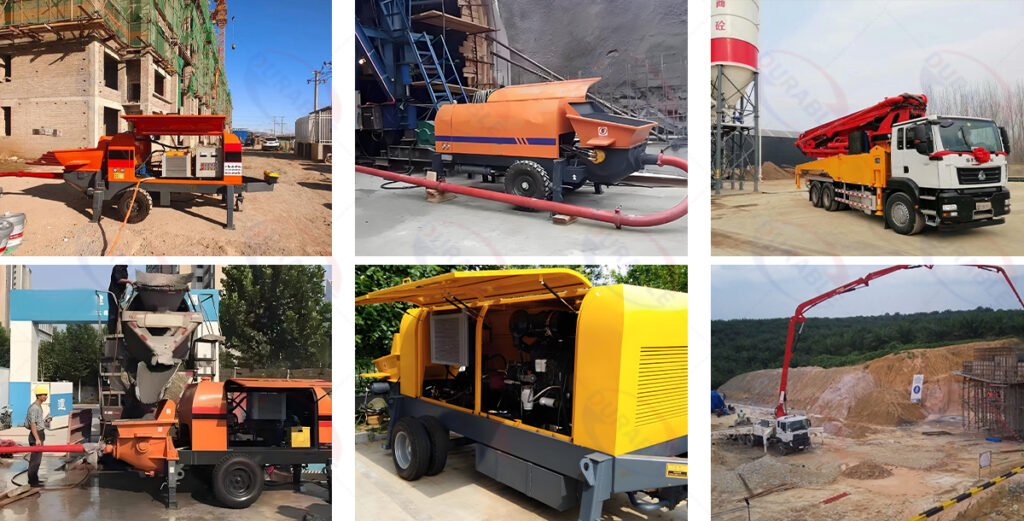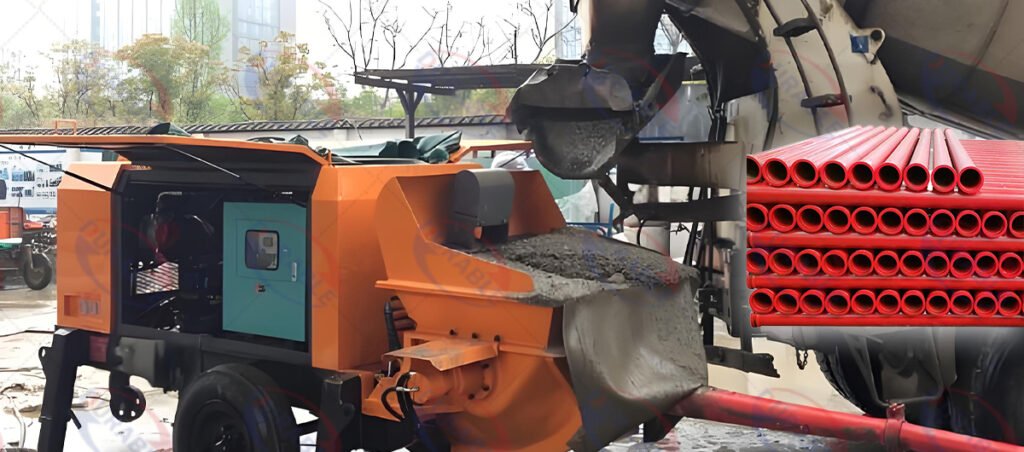How to Solve the 2 Biggest Problems in Concrete Pumping Works
Nothing stops a construction site faster than a concrete pipe blockage. One moment, you have a smooth flow of material, and the next, the engine is straining, the pipeline is shaking, and the entire pour has come to a grinding halt. These concrete pumping problems are costly, dangerous, and often preventable. The root cause is almost always poor concrete pumpability.

As an engineer at Durable, I’ve spent decades helping clients troubleshoot these exact issues. You can have the best concrete pump in the world, but it cannot perform miracles with bad concrete. This guide will walk you through the fundamental reasons for blockages and poor pumpability. More importantly, I will give you the practical solutions to prevent them, saving you time, money, and a lot of headaches on site.
Table of Contents
- What Causes Concrete Pipe Blockages?
- What is Concrete Segregation and How Does It Affect Pumping?
- How to Adjust Concrete Mix Design for Better Pumpability?
- What Besides Slump Affects Concrete Pumpability?
- What is the Safe Process for Clearing a Blockage?
- Frequently Asked Questions
- Summary and Final Advice
- About Durable
What Causes Concrete Pipe Blockages?
A concrete pipe blockage occurs when the concrete stops moving inside the pipeline and forms a solid plug. This is a physical jam. The coarse aggregates (stones) wedge against each other and the pipe wall, creating a dam. The cement paste and water cannot get through, and the pressure in the system spikes to dangerous levels. The pump’s engine strains, but no concrete comes out the other end.
These blockages don’t happen randomly. They almost always occur at points of high friction or restriction. You need to pay close attention to these areas.

- Reducers: A pipe section that narrows the diameter is a very common place for a jam.
- Elbows and Bends: Every sharp turn forces the concrete to change direction, increasing friction and the chance of aggregates bunching up.
- Rubber Hoses: The end hose is flexible, but it can kink or be bent too sharply by workers on site.
- Worn Pipes: Old pipes with rough internal surfaces create more friction than new, smooth pipes.
Practical Tips for Pipe Layout
- Use gradual bends: Always use two 45-degree elbows instead of one sharp 90-degree elbow where possible.
- Minimize reducers: Plan your pipeline to maintain a consistent diameter for as long as possible.
- Support your lines: Securely anchor all pipes to prevent sagging and movement, which can create points of friction.
What is Concrete Segregation and How Does It Affect Pumping?
Concrete segregation is the number one enemy of concrete pumpability. It is the separation of the heavy components (stones and sand) from the cement paste and water. A good, pumpable concrete mix should be cohesive, like a thick, flowing porridge where everything is evenly suspended. When segregation happens, the heavy aggregates fall out of this suspension. Inside the high-pressure environment of a pipeline, this is a disaster. The stones drop to the bottom of the pipe, pile up, and form the beginning of a blockage.
What causes segregation?
- Too Much Water: A very wet or “soupy” mix is the most common cause. The excess water doesn’t have the density to hold the heavy stones in suspension.
- Poor Aggregate Gradation: A mix that lacks a good range of sand particle sizes (fines) won’t have enough paste to properly coat and carry the larger stones.
- Excessive Vibration: Over-vibrating the concrete in the truck or hopper can also cause the heavy aggregates to settle.
A segregated mix is not pumpable. Even if it looks wet and easy to move in the hopper, it will separate under pressure in the pipeline, leading directly to a concrete pipe blockage.
How to Adjust Concrete Mix Design for Better Pumpability?
Preventing concrete pumping problems starts at the batch plant, not at the pump. A proper concrete mix design is your best insurance against blockages. The goal is to create a cohesive mix that stays together under pressure. It needs enough fine material to act as a lubricant, allowing the mix to slide smoothly through the pipe. This begins with the right equipment, like a powerful twin-shaft concrete mixer that can thoroughly combine all ingredients.
Here is how you design for pumpability:
- Optimize Fines Content: Ensure there is enough sand and cement (the “fines”) to create a rich paste. This paste envelops the coarse aggregate, reducing friction. A good starting point is for the sand to be at least 40% of the total aggregate volume.
- Use Well-Graded Aggregates: The aggregate should have a good distribution of sizes, from fine sand to coarse stone. This minimizes voids and creates a denser, more cohesive mix. Avoid “gap-graded” aggregates where a middle size is missing.
- Choose the Right Aggregate Shape: Rounded or cubical aggregates, like river gravel, flow much better than flat, elongated, or crushed aggregates with sharp angles. Sharp particles are more likely to interlock and jam.
- Control Water Content: The slump should be correct—typically between 100mm and 150mm (4 to 6 inches) for pumped concrete. But avoid just adding water on site. Use a water-reducing admixture (plasticizer) to increase flowability without causing segregation.
| Bad Mix (High Blockage Risk) | Good Pumpable Mix (Low Risk) | Why It Matters for You |
|---|---|---|
| Low sand content (<35%) | High sand content (40-45%) | More paste to lubricate the pipes and prevent friction. |
| Gap-graded or large, sharp stone | Well-graded, rounded aggregate | Smooth particles flow easily; sharp ones jam together. |
| High water content (soupy) | Controlled slump with admixtures | Prevents segregation and ensures a cohesive, stable mix. |
| Inconsistent from truck to truck | Consistent, verified batches | Predictable performance and much lower risk of sudden problems. |
What Besides Slump Affects Concrete Pumpability?
Many people on a construction site judge concrete only by its slump. A high slump means it’s “wet,” so it must be easy to pump, right? This is a dangerous oversimplification. While slump is a measure of consistency, it does not tell the whole story of concrete pumpability. A mix can have a high slump and still be unpumpable if it is not cohesive.
Here are other critical properties to consider:
- Cohesiveness: This is the ability of the concrete to stick together and resist segregation. A cohesive mix will not bleed excess water and will hold its shape. You can test this informally by patting a sample with a shovel. If it holds together without falling apart or leaving a watery mess, it has good cohesion.
- Aggregate Gradation: I mention this again because it is so important. The mix needs a good balance of particle sizes. Too much coarse aggregate and not enough sand creates a “bony” mix that is harsh and difficult to pump.
- Lubrication: A good pumpable mix creates a thin lubricating layer of cement paste and fine sand along the inside of the pipe wall. This layer is what allows the bulk of the concrete to slide through with minimal friction. Without it, you get a concrete pipe blockage.
Relying only on the slump cone is a mistake. You need to look at the concrete, feel it, and understand its properties to truly know if it will pump well.
What is the Safe Process for Clearing a Blockage?
When a concrete pipe blockage happens, the first rule is: Safety First. The pipeline contains stored energy. A pipe clamp that is opened incorrectly can fly off with explosive force, causing serious injury.
NEVER stand in front of a clamp or joint you are about to open.
Here is the standard, safe procedure for handling a blockage:
- Stop the Pump: Immediately shut down the pump.
- Relieve Pressure: Cycle the pump in reverse for a few seconds. This will draw some of the pressure off the blockage.
- Locate the Jam: Carefully tap along the pipeline with a hammer, starting from the pump. The pipe will sound dull and solid up to the point of the blockage, and will ring hollow after it. The blockage is usually in the first few meters of the solid-sounding section.
- Isolate the Section: Identify the clamps on either side of the jam. Go to the clamp on the PUMP side of the blockage first.
- Open Safely: Slowly and carefully loosen the clamp, making sure no one is in front of it. Be prepared for a sudden release of concrete. If the blockage is under extreme pressure, you may need to break a small hole in the pipe to relieve it before opening a clamp.
- Clear the Blockage: Once the section is open, use a rod or pressurized water to clear the hardened concrete.
- Reassemble and Prime: Clean the joints, reassemble the pipe, and be sure to re-prime the line with a cement slurry before attempting to pump again.
If you are unsure or the blockage is severe, do not take risks. It is better to call for experienced help than to risk an accident. For complex jobs, a versatile machine like a concrete mixer pump can offer more flexibility in managing the pour.
Frequently Asked Questions
1. Can I just add more water to make the concrete pump better?
No, this is the worst thing you can do. Adding excess water leads directly to concrete segregation, which is the primary cause of blockages. Use a chemical admixture (plasticizer) if you need more flow.
2. How often should I clean the pipeline?
The pipeline must be thoroughly cleaned with water and a sponge ball (rabbit) immediately after every pour. Any concrete left inside will harden and cause a blockage on the next job.
3. Does the outside temperature affect concrete pumping?
Yes. In very hot weather, the concrete can lose slump and start to set in the pipeline, increasing blockage risk. In freezing weather, water in the mix or pipeline can freeze, causing a dangerous ice plug.
Summary and Final Advice
Most concrete pumping problems can be traced back to the mix. A concrete pipe blockage is a symptom; poor concrete pumpability is the disease. The best way to ensure a smooth pour is to focus on prevention.
- Insist on a pumpable mix design. Work with your concrete supplier.
- Inspect every truck. Ensure the concrete is consistent and not segregated.
- Use proper pipe layout. Avoid sharp bends and kinks.
- Communicate. The pump operator, truck driver, and site foreman must work as a team.
Investing in a high-quality machine like a Durable concrete boom pump is a great start, but true success comes from mastering the entire process, from the batch plant to the end of the hose.
About Durable
Since 2001, Durable Machine has been a leading manufacturer of concrete pumps, mixers, and batching plants. We are a factory-direct B2B supplier, delivering robust and reliable machinery to over 120 countries. We provide complete solutions, including equipment design, installation, and operator training, to ensure our clients’ projects run smoothly and profitably.
Facing pumping challenges on your site? Contact our engineering team today for expert advice and a quote on a pumping solution designed for your needs.
 Durable Machinery
Durable Machinery